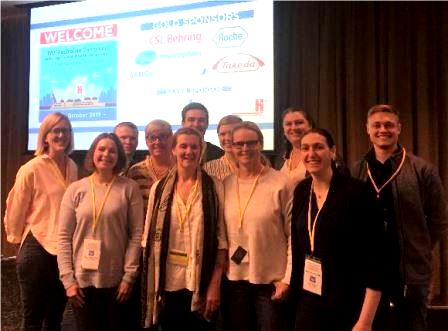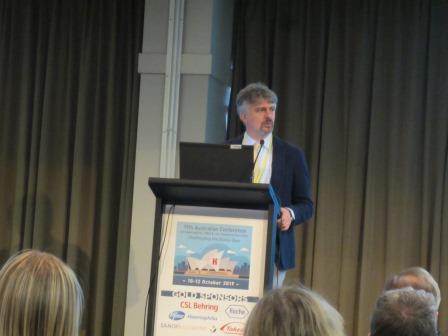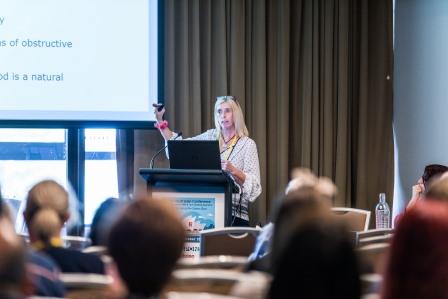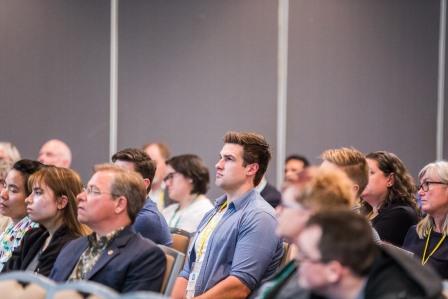JOSHUA HUTTON AND JOSHUA WAKEFIELD
Joshua Hutton and Joshua Wakefield are Physiotherapists, Royal Prince Alfred Hospital, Sydney, NSW

Photo: Australian and New Zealand physiotherapists with Greig Blamey at the Conference
The 19th Australian Conference on haemophilia, VWD & rare bleeding disorders launched in a Galaxy Far, Far Away (the Manly Novotel) with Dr Liane Khoo’s Star Wars flavoured opening address and recap of the history of management for people with bleeding disorders.
The presentations across both days certainly kept true to the theme of the conference, Challenging the status quo, with extended crowd participation and engagement in many of the plenary sessions.
Plenary 1: Improving outcomes – what has been achieved in the treatment of bleeding disorders?

Professor Alfonso Iorio spoke about pharmacokinetic (PK) profiling software that utilises a vast database to accurately predict PK measures for individuals over time; a truly innovative and progressive development from the status quo.
Plenary 2: Dr Happy (Dr Tim Sharpe) – Challenging the status quo
Dr Happy (Dr Tim Sharpe) presented on the positive psychology movement and outlined 9 steps for leading a happy life. Intrigued by the prospect of 9 simple steps for happiness, members of the audience enquired further about the role of social media and technology in psychological wellbeing. Dr Happy outlined the need for perspective when using social media and highlighted the importance of mentoring and monitoring young people engaging with technology.
Plenary 3: Musculoskeletal challenges: joint care and treatment
We were once again enthralled by Dr Rob Russo presenting on the benefits of ultrasound in assisting with diagnosis of bleeds and arthropathy. The real-time ultrasound demonstrations with both a patient and a physiotherapist volunteer captured the attention of patients, families and health practitioners. This is truly an exciting time to be part of the bleeding disorders community! Dr Mark Horsley had the enviable job of presenting after Dr Russo, but managed to keep the audience locked in with a presentation on surgical interventions for arthropathy. Dr Horsley continued with the narrative that ran throughout the conference that prevention is always better than cure, and encouraged all patients and families to remain diligent in bleed monitoring, treatment and exercise.
Plenary 4 – New opportunities or is the status quo good enough?
Claude Damiani gave an insightful presentation on the impact of the ever-changing treatment space from a parent perspective and encouraged us all to consider the individual in making key treatment decisions. Advances in extended half-life products and gene therapy were of particular interest to many in the room; however, it was acknowledged that there are significant barriers to treatment development and access. Dr Simon McRae spoke about some barriers to access experienced in Australia including payment models, regulatory and policy considerations and the need for comprehensive, methodologically sound studies and a framework of comparison. Robyn Shoemark, the CNC at Westmead Children’s Hospital, spoke about the role of nursing moving into the future. Robyn highlighted the important role nurses will play in the future, particularly in regard to communication with patients in the ever-changing treatment landscape.

Jules Aitken presenting on managing diet and weight
In addition to these plenary sessions, there were several concurrent that attendees raved about during the breaks. The concurrent session A healthy life for all ages was particularly interesting with a great mix of presenter personality and information. Jules Aitken spoke about the issues around obesity in people with bleeding disorders and gave some very helpful tips around diet (which were swiftly forgotten come lunch time). In this session we also heard from Greig Blamey and Tim, but a little bit more about them below.
The Self-advocacy session was facilitated by social workers Loretta Riley and Nicoletta Crollini and Dr Liane Khoo and was well attended by healthcare professionals, patients and families alike. Patients sharing examples of how they advocated for themselves was both inspiring and informative. Barriers to self-advocacy were also discussed and provided valuable insights for clinicians on how to facilitate an open, welcoming environment where we can provide best care to achieve best outcomes.
Patient stories were also prominent in the conference this year, and provided a valuable insight into the patient journey. John spoke about living with haemophilia for over 50 years, and explained how advances in medications and treatment approaches have changed his quality of life and function. John gave a fantastic account of what it was like growing up with haemophilia and the isolation he experienced at times when there were contraindicated activities. However, he reports today that he is now more active and engaged in physical activity than he ever has been.

Patients and clinicians alike were thrilled to learn that Greig Blamey had agreed to come to the other side of the world to attend as a keynote speaker. Greig is a Canadian physiotherapist who works with people with bleeding disorders and is the current Chair of the World Federation of Hemophilia Musculoskeletal Committee. His passion for not only treating but advocating for people with bleeding disorders is truly infectious. During his presentations, Greig explained the important role physiotherapy plays in maintaining good joint health by engaging and monitoring resistance and aerobic activity. It was refreshing to hear that the Canadian health system has begun to focus on the multidisciplinary treatment of haemophilia. He also highlighted the importance of patients communicating regularly with the multidisciplinary team to ensure that any bleeding events can be actioned early to prevent or reduce joint damage.
Greig spoke about the importance of working with an experienced physiotherapist to find an activity, sport or exercise regime that reflects the individual’s function, medical needs, goals and interests. Greig used the terms independent, pre-dependent and dependent to categorise functional status and highlighted how different levels of dependence require different management plans to compliment people’s goals and needs. In essence, the treatment of people with haemophilia-related musculoskeletal conditions should not diverge from the principles of exercise whereby people undertake a frequency, intensity, duration and type of exercise that is specific to the demands of their sport, activities of daily living or goals.
A salient feature of Greig’s presentation was that extraordinarily gifted athletes exist in all populations and why should they not be afforded the same opportunities as their peers? This was a theme which also arose in discussions at the Australia and New Zealand Physiotherapy Haemophilia Group (ANZPHG) meeting held at the conference. Some outstanding therapists from Australia and New Zealand presented cases of fantastic young athletes competing at the elite level in their respective sports.
This idea made a world of sense when I stood next to some very impressive athletes and members of the community living with bleeding disorders who described their journeys and how beneficial sport and resistance exercise have been from musculoskeletal and social perspectives. Tim is a formidable athlete living with haemophilia who enlightened the conference attendees with his story so far. He is capable of squatting up to 200 kilograms and bench pressing 160 kilograms! Interestingly, Tim reports he experiences less bleeds now that he is training regularly; real-world evidence of a shift away from the status quo perhaps? Not only has Tim developed an impressive physique, he also works full-time as a paramedic, a truly inspirational character indeed. Tim noted that his progress in the gym and in a physically demanding occupation was not an overnight process, and went on to emphasise the importance of working closely with his multidisciplinary team.
The presentations across the Conference by all parties were enlightening and informative.
Thank you to Haemophilia Foundation Australia and the sponsors for a conference that was thoroughly enjoyed by all.
Haemophilia Foundation Australia acknowledges the Traditional Owners and Custodians of Country throughout Australia, the land, waters and community where we walk, live, meet and work. We pay our respects to Elders past and present and extend that respect to all Aboriginal and Torres Strait Islander peoples.
Sign up for the latest news, events and our free National Haemophilia magazine